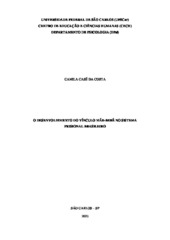| dc.contributor.author | Costa, Camila Casé da | |
| dc.date.accessioned | 2022-05-03T11:18:28Z | |
| dc.date.available | 2022-05-03T11:18:28Z | |
| dc.date.issued | 2022-04-29 | |
| dc.identifier.citation | COSTA, Camila Casé da. O desenvolvimento do vínculo mãe-bebê no sistema prisional brasileiro. 2022. Trabalho de Conclusão de Curso (Graduação em Psicologia) – Universidade Federal de São Carlos, São Carlos, 2022. Disponível em: https://repositorio.ufscar.br/handle/ufscar/15971. | * |
| dc.identifier.uri | https://repositorio.ufscar.br/handle/ufscar/15971 | |
| dc.description.abstract | In Brazil, with the increase of the female prison population by 267.8%, over almost twenty years, questions arise about the particularities of this public and what involves the lives of women in prison. One of them is motherhood, since more than half of them have children and this implies, in most cases, separation and bond breaking. Outside prison bars, mothers are most often configured as primary caregivers and their absence weakens family relationships; inside them, there are lonely mothers, with ambivalent and guilty feelings, and who may also be, for a short time, in the presence of a baby, whether during pregnancy or postpartum, experiencing a hyperbolic version of the motherhood. Given this, it was intended to investigate the experience of becoming a mother behind bars and to analyze the variables involved in the process of gestating, giving birth and living with the child in this environment, such as its implications for the formation of the mother-baby bond. Three woman incarcerated in a female penitentiary in the state of São Paulo participated. Two interviews were carried out by videoconference with each participant, one during their pregnancy and one in the postpartum period, in addition to applying the Questionnaire on Burdening Experience at this first moment. Through the qualitative analysis of the data obtained, similarities and differences in the exercise of motherhood of the participants in the prison environment were perceived. Regarding the similarities, the prison history, the adverse experiences of emotional abuse and emotional neglet, and the large number of mentions to the family support and the suffering resulting from the imprisonment and separation of the baby stand out. The differences were in the life story, in the experiences of physical abuse and in the decision about the moment of separation. From the analysis of the data obtained in this research, it was expected to be produce additional scientific knowledge about the theme of motherhood in Brazilian prisons, which can contribute to further intervention projects development for this target population. | eng |
| dc.description.sponsorship | Fundação de Amparo à Pesquisa do Estado de São Paulo (FAPESP) | por |
| dc.language.iso | por | por |
| dc.publisher | Universidade Federal de São Carlos | por |
| dc.rights | Attribution-NonCommercial-NoDerivs 3.0 Brazil | * |
| dc.rights.uri | http://creativecommons.org/licenses/by-nc-nd/3.0/br/ | * |
| dc.subject | Gestação | por |
| dc.subject | Maternidade | por |
| dc.subject | Mulheres | por |
| dc.subject | Prisão | por |
| dc.subject | Pós-parto | por |
| dc.subject | Vínculo | por |
| dc.subject | Gestation | eng |
| dc.subject | Motherhood | eng |
| dc.subject | Women | eng |
| dc.subject | Prision | eng |
| dc.subject | Postpartum | eng |
| dc.subject | Bond | eng |
| dc.title | O desenvolvimento do vínculo mãe-bebê no sistema prisional brasileiro | por |
| dc.title.alternative | The development of the mother-baby bond in the Brazilian prison system | eng |
| dc.type | TCC | por |
| dc.contributor.advisor1 | D'Affonseca, Sabrina Mazo | |
| dc.contributor.advisor1Lattes | http://lattes.cnpq.br/0381029115416584 | por |
| dc.description.resumo | No Brasil, com o aumento da população carcerária feminina em 267,8%, ao longo de quase vinte anos, surgem questões acerca das particularidades desse público e do que envolve a vida das mulheres na prisão. Uma delas é a maternidade, visto que mais da metade delas têm filhos e isso implica, na maioria dos casos, na separação e na quebra de vínculo. Do lado de fora das grades, as mães na maioria das vezes se configuram como cuidadoras primárias e suas ausências fragilizam as relações familiares; do lado de dentro, existem mães solitárias, com sentimentos ambivalentes e de culpa, e que também podem estar, por um curto período, no convívio de um bebê, seja na gestação ou no pós-parto, vivenciando a maternidade de maneira superdimensionada. O presente estudo teve como objetivo investigar a experiência de se tornar mãe atrás das grades e analisar as variáveis envolvidas no processo de gestar, parir e conviver com o filho nesse ambiente, tais como suas implicações na formação do vínculo mãe-bebê. Participaram três mulheres em privação de liberdade em uma penitenciária feminina do Estado de São Paulo. Foram realizadas, por videoconferência, duas entrevistas com cada participante, uma durante a gravidez e uma no período pós-parto, além de aplicado o Questionário de Eventos Estressores nesse primeiro momento. Por meio da análise qualitativa dos dados obtidos, foram percebidas semelhanças e diferenças no exercício da maternidade das participantes no ambiente prisional. Com relação às semelhanças, destaca-se o histórico prisional, as experiências adversas de abuso e negligência emocional, e o grande número de menções à rede de apoio familiar e ao sofrimento decorrente da reclusão e da separação do bebê. Já as diferenças se deram no histórico de vida, nas vivências de abuso físico e na decisão sobre o momento de separação. A partir da análise dos dados obtidos, esperou-se produzir um conhecimento científico a respeito da temática da maternidade no cárcere brasileiro que contribua para propostas de intervenções com esse público-alvo. | por |
| dc.publisher.initials | UFSCar | por |
| dc.subject.cnpq | CIENCIAS HUMANAS::PSICOLOGIA::TRATAMENTO E PREVENCAO PSICOLOGICA | por |
| dc.description.sponsorshipId | 2021/03046-8 | por |
| dc.publisher.address | Câmpus São Carlos | por |
| dc.contributor.authorlattes | http://lattes.cnpq.br/0690508921145567 | por |
| dc.publisher.course | Psicologia - Psi | por |

